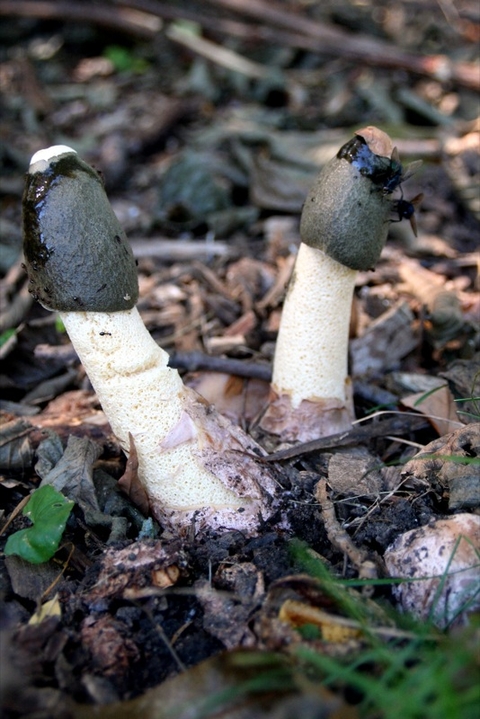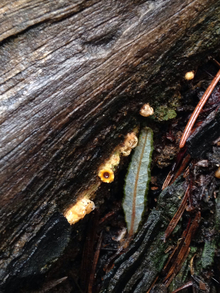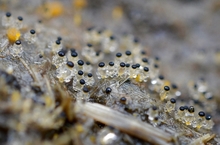Quick facts
- Slime molds are present in all soils.
- They are common on decaying logs, fallen leaves, mulch, lawns with excessive thatch and on strawberry leaves.
- Control is not usually necessary and they will disappear during hot, dry weather.
- Stinkhorns can be found in lawns, around the base of dead trees, or in flowerbeds mulched with wood chips.
- They are commonly found near uprooted trees, near decayed logs or in humus.
- They are produced during wet, cool periods in late summer and fall.
- They are not harmful and no control is necessary.
- Bird's nest fungi, sphere throwers, and shotgun fungi all grow on manure or decaying wood.
- Since these fungi live only on decaying plant matter, they do not harm living plants.
Slime molds
In North America, there are hundreds of species of slime molds. In any one location, there can be up to 50 different kinds.
- Although typically classified as fungi, slime molds are unique in their development.
- Slime molds survive winter in soil and thatch layers as spores.
- During cool, wet weather, spores germinate and produce single-celled amoeba-like spores (swimming spores).
- The spores feed on microorganisms and organic matter until something causes them to join together.
These aggregations, called plasmodia, move up out of the soil onto the surface of mulch, wood chips, grass blades and plant stems. Plasmodia usually appear as white, yellow, gray, or purplish-brown, jelly-like masses. As plasmodia dry, they appear crusty and powdery.
Later, crusty reproductive structures called sporangia form. Spores produced from these structures are spread by wind, water, equipment, people or animals. Spore dispersal is aided by the height gained on grass blades or plant stems.
Slime molds are not parasitic, so they do not cause plant disease. But heavy coverage on grass or plant leaves may cause yellowing.
- Control is not usually necessary and slime molds will disappear during hot, dry weather.
- Slime molds may be washed, brushed or raked from affected areas.
- Frequent mowing will quickly remove these fungi on rapidly growing grass.
Stinkhorns
Several different kinds of stinkhorns can be found in Minnesota.
- Stinkhorns can be found in lawns, around the base of dead trees, or in flowerbeds mulched with wood chips.
- In the woods, they are commonly found near uprooted trees, near decayed logs or in humus.
- They are usually produced during wet, cool periods in late summer and fall.
- They are not harmful, and no control is necessary.
Young stinkhorns develop within a round or flattened egg, one to three inches in diameter, which may be white, pink, lilac or beige. Do not eat stinkhorn eggs.
Cutting through a mature egg will reveal a fully developed mushroom cap with spores. Eventually, the mushroom stalk, also inside the egg, elongates. Under ideal conditions, stalks may elongate in as little as one half-hour.
The tip of the horn or cap is often covered with green, sticky slime that has a bad odor. This slime contains sticky spores and attracts flies that spread the fungal spores.
The fully developed fruiting body may range from 6 to 10 inches in height and is more or less horn shaped.
Bird's nest fungi, sphere throwers and shotgun fungi
Bird's nest fungi (Mycocalia, Nidularia, Nidula, Cyathus, and Crucibulum spp.), sphere throwers (Sphaerobolus spp.), and shotgun fungi (Pilobolus spp.) are three separate groups of fungi with many similarities.
They are all saprophytes, which grow on manure or decaying wood. Since these fungi live only on decaying plant matter, they do not harm living plants.
In the garden, the tiny fungi (under 1/4 inch tall) are usually found on the surface of soil that has been enriched with manure, sawdust or wood chips. They can also be found on old boards used to edge garden beds and on wooden plant labels and stakes.
The fungi are usually spread in manure, but some species may contaminate seed mixes.
All of these fungi can forcibly eject their spores in hard egg-like structures called peridioles. These structures can be ejected 3 feet or more. The sticky spore cases adhere to plant leaves and other surfaces, including home siding and patio furniture.
These fungi are rarely noticed unless they are brought indoors on container-grown plants. The first sign is shiny black or dark brown growths that look like seeds or insects on the leaves. These are the egg-like structures that have been ejected by the fungi. They can be picked off the leaves.
To help control these fungi, remove any fungal fruiting bodies from the surface of the soil. Repot the plant in a potting medium that does not contain manure or wood to prevent the fungi from returning.
Bird's nest fungi
- Look like miniature bird's nests or cups.
- Shiny peridioles are nestled inside like eggs.
- Usually only 1/4 inch in height or diameter.
- Commonly light brown but may be white, gray, yellow or rust colored.
- The shiny peridioles are generally black or dark brown but may also be white.
- Immature fruiting bodies look like tiny puffballs, which open into cups as they mature.
The peridioles of bird's nest fungi are splashed out of the nest by falling water drops. The dimensions and shape of the nest are such that the force of a water drop hitting the bottom of the cup is enough to throw the peridioles over one yard from the nest.
- When a peridiole hits a solid object such as a leaf or twig, it sticks to the surface in one of two ways. Fungi in the genera Mycocalia, Nidularia and Nidula have sticky peridioles.
- In the genera Cyathus and Crucibulum, the peridiole is attached to the nest by a coiled cord. When the peridiole is ejected from the nest, the cord separates from the nest, giving the peridiole a four-inch tail. The end of the tail is sticky. When it sticks to a twig or stem, the peridiole swings around its anchor point, wrapping the cord around the stem.
Most bird's nest fungi in Minnesota belong to Cyathus or Crucibulum.
Sphere throwers (Sphaerobolus spp.)
- Grow on rotting wood in many of the same places as bird's nest fungi.
- The whitish or yellowish-pink immature fruiting bodies are round balls similar to immature bird's nest fungi.
- As the fruiting bodies mature, the outer layer of the ball peels back to form a cup with a single round peridiole inside. This cup is actually two cups, one inside the other, joined at the rim.
- Pressure builds up between the two cups, eventually causing the inner cup to explosively invert, or turn inside out.
- The force of the inversion launches the peridiole, which can travel more than five yards before sticking to any surface it impacts.
Shotgun fungi (Pilobolus spp.)
- Grow mostly on old horse manure.
- Clear, glasslike fruiting body consists of a slender stalk topped with a swollen bulb.
- A shiny black peridiole rests on top of the bulb.
Pilobolus bends toward the light, which ensures the clearest path for the peridiole to travel. The fungus senses the direction of the light with light sensitive pigments at the base of the bulb. As long as these pigments are illuminated, they send a signal to bend. The bending stops when the opaque peridiole is pointing directly at the light source, shading the pigments.
If grown in the dark, the stalks will all point straight up. The swollen bulb is filled with sugar, which absorbs water until the pressure inside the bulb is five times the pressure outside. As the fruiting body matures, the walls weaken under the peridiole. Eventually the pressure causes the bulb to rupture, sending the sticky peridiole flying.
These ballistic fungi, each with its unique method of spore dispersal, can be a fascinating introduction to the world of fungi. A careful search of the damp corners of your garden in the fall will probably reveal numerous bird's nest fungi, sphere throwers and shotgun fungi.
Reviewed in 2024






